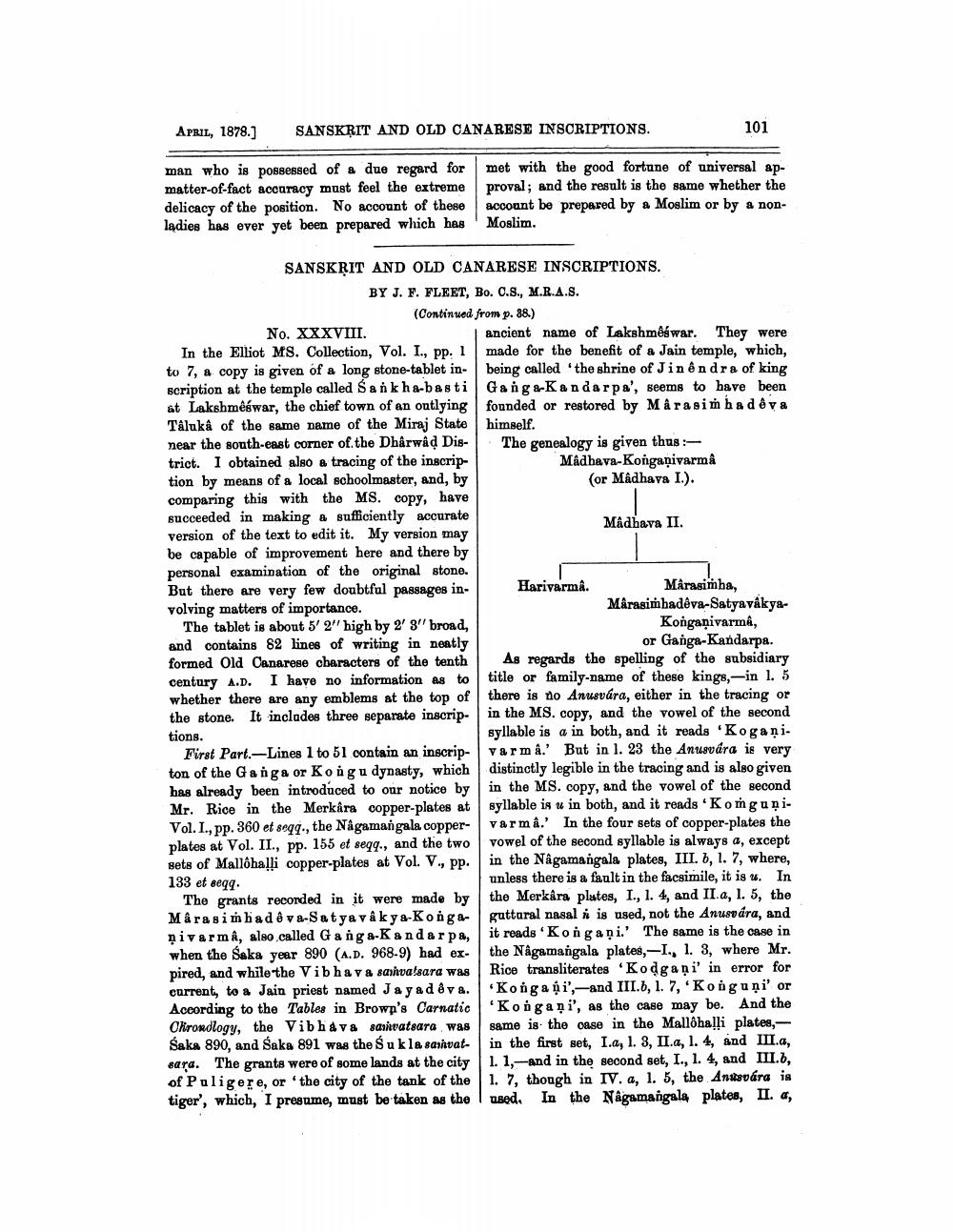________________
APRIL, 1878.)
SANSKRIT AND OLD CANARESE INSCRIPTIONS.
101
man who is possessed of a due regard for met with the good fortune of universal apmatter-of-fact accuracy must feel the extreme proval; and the result is the same whether the delicacy of the position. No account of these account be prepared by a Moslim or by a nonladies has ever yet been prepared which has 'Moslim.
SANSKRIT AND OLD CANARESE INSCRIPTIONS.
BY J. F. FLEET, Bo. C.S., M.R.A.S.
(Continued from p. 38) No. XXXVIII.
ancient name of Lakshmêswar. They were In the Elliot MS. Collection, Vol. I, pp. I made for the benefit of a Jain temple, which, to 7, a copy is given of a long stone-tablet in- being called 'the shrine of Jinêndra of king scription at the temple called Sankha-basti Gang -Kandarpa', seems to have been at Lakshmeswar, the chief town of an outlying founded or restored by Marasimhadeva Taluka of the same name of the Miraj State himself. near the south-east corner of the Dharwad Dis- The genealogy is given thus :trict. I obtained also a tracing of the inscrip
Madhava-Kongañivarma tion by means of a local schoolmaster, and, by
(or Madhava I.). comparing this with the MS. copy, have succeeded in making a sufficiently accurate
Madhava II. version of the text to edit it. My version may be capable of improvement here and there by personal examination of the original stone. But there are very few doubtful passages in- Harivarma.
Mârasimha, volving matters of importance.
Mârasimbadêva-SatyavákyaThe tablet is about 5' 2high by 2' 3'' broad,
Konganivarma, and contains 82 lines of writing in neatly
or Ganga-Kandarpa. formed Old Canarese characters of the tenth As regards the spelling of the subsidiary century A.D. I have no information as to title or family-name of these kings,-in l. 5 whether there are any emblems at the top of there is no Anusvára, either in the tracing or the stone. It includes three separate inscrip- in the MS. copy, and the vowel of the second tions.
syllable is a in both, and it reads Kogani. First Part.-Lines 1 to 51 contain an inscrip- varma.' But in 1. 23 the Anusvára is very ton of the Ganga or Kongu dynasty, which distinctly legible in the tracing and is also given has already been introduced to our notice by in the MS. copy, and the vowel of the second Mr. Rice in the Merkâra copper-plates at syllable is u in both, and it reads Konguņi. Vol. I, pp. 360 et seqq., the Nagamangala copper- varma.' In the four sets of copper-plates the plates at Vol. II., pp. 155 et seqq., and the two vowel of the second syllable is always a, except sets of Mallohalli copper-plates at Vol. V., pp. in the Nagamangala plates, III, 6, 1.7, where, 133 et seqq.
unless there is a fault in the facsimile, it is . In The grants recorded in it were made by the Merkâra plates, I., 1. 4, and II.a, 1. 5, the Marasin bad ê va-Satya vakya Kong-guttaral nasal i is used, not the Anusvára, and nivarmA, also called Ganga-Kandarpa, it reads 'Kong ani.' The same is the case in when the Saka year 890 (A.D. 968-9) had ex- the Nâgamangala plates, -I., 1. 3, where Mr. pired, and while the Vibhav & sarivalsara was Rice transliterates 'Kodgaại' in error for current, to a Jain priest named Jayad & v&. Kongaội',-and III.6, 1. 7, 'Kong uņi' or According to the Tables in Brown's Carnatic Kongani', as the case may be. And the Okrondlogy, the Vibhava sasivatsara was same is the case in the Mallohalli plates, Saka 890, and Saka 891 was the śukla sasivat- in the first set, I.a, 1. 3, II.a, 1. 4, and III.a, sara. The grants were of some lands at the city 1. 1,--and in the second set, I., 1. 4, and III.6, of Puligere, or the city of the tank of the 1. 7, though in IV.a, 1. 5, the Anusvára is tiger', which, I presume, must be taken as the used. In the Nagamangala plates, II. a,




